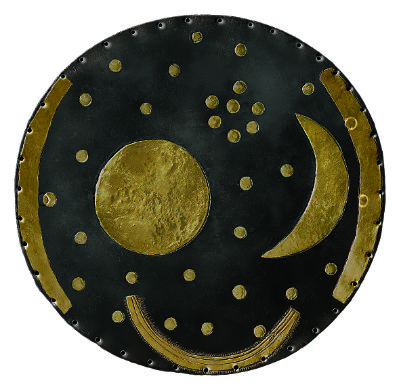Phases
The Phases of the Nebra Sky Disc
The Sky Disc was deposited on the Mittelberg hill together with the accompanying finds at around 1600 BC – the end of the Early Bronze Age.
The current appearance of the Sky Disc is the result of a series of modifications that probably spanned a period of 150 to 200 years. So far we can distinguish five phases.
The original colour of the disc was probably a lustrous black. Today, the green of the corroded bronze is dominant.

Phase 1: Second half 18th century BC
The original version of the disc shows a sky with 32 stars, a lunar crescent, and a full moon or sun. All celestial bodies keep a distinct distance from one another. The only recognisable cluster of stars is a group of seven closely placed golden dots: the Pleiades.
You can find out what these "calendar stars" and an associated leap rule are all about in the ArchaeoStory on the Astronomy of the Sky Disc and in the poster exhibition.

Phase 2: First half 17th century BC
In the next phase, two golden arcs were attached to the edge of the Sky Disc. One of them is missing today, but is still visible from its fastening groove. The adjacent star had been moved before the fixing of the arc. Beneath the retained arc the outlines of two further stars are clearly visible in relief. Both stars had been removed before the arc was attached.
But what is the significance of the arcs? It’s worth having another look at the ArchaeoStory on the Astronomy of the Sky Disc and at the poster exhibition.

Phase 3: Mid-17th century BC
On the Nebra Sky Disc one golden ornament differs significantly from the others: the grooved arc at the lower edge. This gold sheet cannot be explained as a natural astronomical phenomenon.
According to its shape and decoration, we can interpret it as a ship, a kind of sky barge, which cruises along the horizon propelled by oars.
But why is such a ship on the Sky Disc? Here, too, it helps to look in the ArchaeoStory on the Astronomy of the disc and the poster exhibition.

Phase 4: End 17th century BC
In the next phase the edge of the bronze disc was perforated. Presumably the disc was once attached a support made of organic material. The perforation disregards the gold ornaments. This shows that the use of the Sky Disc had changed. Evidently, its display was now more important, for example
as a flag-like standard.
In our poster exhibition we show you how we know about such flag-like standards.

Phase 5: Around 1600 BC
The Nebra Sky Disc was carefully deposed 3,600 years ago together with other selected bronze objects. Everything suggests that one horizon arc had been removed before the disc was deposited.
The disc was apparently also separated from its support material. Remains of a fastening passed through the holes could not be found.
© LDA, Graphics: Klaus Pockrandt.
All five phases of the Sky Disc can be reconstructed in an interactive 3D model.